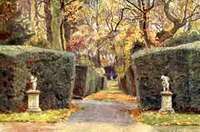But nearer at hand the Fern walk has its own little pictures. In early summer there are patches of Trillium, the white Wood Lily, in cool hollows among the ferns, and, some twenty paces further up, another wider group of the same. Between the two, spreading through a mossy bank, in and out among the ferns and right down to the path, next to a coming patch of Oak Fern, is a charming little white flower. Its rambling roots thread their way under the mossy carpet, and every few inches throw up a neat little stem and leaves crowned with a starry flower of tenderest white. It is Trientalis, a native of our most northern hill-woods, the daintiest of all woodland flowers.
To right and left white Foxgloves spire up among the Bracken. When the Foxglove seed is ripe, we remember places in the wood where tree-stumps were grubbed last winter. A little of the seed is scattered in these places and raked in. Meanwhile one forgets all about it, till two years afterwards there are the stately Foxgloves. It is good to see their strong spikes of solid bloom standing six to seven feet high, and then to look down again at the lowly Trientalis and to note how the tender little blossom, poised on its threadlike stem, holds its own in interest and importance.
Further up the Fern walk, near the upper group of Trillium, are some patches of a plant with roundish, glittering leaves. It is a North American Asarum (A. virginicum); the curious wax-like brown and greenish flower, after the usual manner of its kind, is short-stalked and hidden at the base of the leaf-stems. Near it, and growing close to the ground in a tuft of dark-green moss, is an interesting plant�Goodyera repens, a terrestrial Orchid. One might easily pass it by, for its curiously white-veined leaves are half hidden in the moss, and its spike of pale greenish-white flower is not conspicuous; but, knowing it is there, I never pass without kneeling down, both to admire its beauty and also to ensure its well-being by a careful removal of a little of the deep moss here and there where it threatens too close an invasion.
Now there comes a break in the Fern walk, or rather it takes another character. The end of one of the wide green ways that we call the Lily path comes into it on the right, and immediately beyond this, stands the second of the great Scotch Firs of the older wood. The trunk, at five feet from the ground, has a girth of nine and a half feet. The colour of the rugged bark is a wonder of lovely tones of cool greys and greens, and of a luminous deep brown in the fissures and cavities. Where the outer layers have flaked off it is a warm reddish grey, of a quality that is almost peculiar to itself. This great tree's storm-rent head towers up some seventy feet, far above the surrounding foliage of Oak and Birch. Close to its foot, and showing behind it as one comes up the Fern walk, are a Holly and a Mountain Ash.

